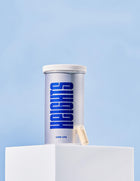
Yesterday’s pizza—Food for the gut
Why cold Margherita might just be the best thing you’ve eaten all day.

The third part of a three-part series—here are some great and easy tips to increase microbiome diversity without breaking the bank.
So far, we’ve looked at the microbiome pyramid , and the ways that certain food and drink can affect your gut bacteria. But there are lots of foods that are great for your gut, and today, we’re going to be going through three of my favourite ways to be kind to your microbiome.
Resistant Starch
When we flick over a list of ingredients, we probably don’t consider how the same word can mean very different things for our bodies. This can depend on how it was prepared, cooked or processed. Take potatoes, for instance.
“100% potato” could mean a few things:
-
A raw potato (although never eat a raw potato)
-
A potato roasted at 180ºC
-
A boiled potato
-
Yesterday’s boiled potato
Interestingly, they all have completely different nutritional profiles and effects on our bodies.
The raw potato might have lectins and a toxic alkaloid called solanine , which can also be indicated by potatoes going green. Solanine can make people quite ill and this is one of the good reasons why you should keep spuds out of light and not eat them raw!
Last week, we discussed how starches roasted to high temperatures can create acrylamide, and roasted or fried spuds are a culprit. Even though cooking a potato at high temperatures increases the production of acrylamide, giving them a quick blanch before might help reduce it .
But what if we compared a freshly boiled spud with yesterday’s? Are they the same?
They’re not—yesterday’s might be better for your gut!
The starch in potatoes can turn into resistant starch—think of the carbohydrates becoming little crystals that are harder to digest. The perks of this are twofold—a lower glucose spike when we eat it, and to feed our microbiome —who in return produce useful short chain fatty acids (SFCAs) for us. Resistant starch is a top tip for improving microbiome diversity and you don’t even need to go out of your way to get it.
Even better, its not just spuds but also wheats (like in cold pasta) too, so batch cooking helps save cash and your gut bugs!
Fermented Food
The best bit about fermented foods might not be the bacteria in them. A lot of research is still exploring whether the bugs from fermented foods make it to the bowel.
So how then could these fermented foods be useful for the gut? Well, it might be what we’re fermenting to begin with… kimchi and sauerkraut, for instance, are from the family Brassicaceae (cabbages, basically), which we know improves microbiome diversity and helps us produce useful compounds, like sulfurophane. Similarly, a sourdough will have more complexity of fibres after fermentation than factory-made bread.
What’s the common denominator? Variety.
Variety doesn’t just mean ‘more’ different things - it can mean more compounds from within the same food! When fermentation breaks food up into different building blocks, different gut bugs can be fed with them - especially if we didn’t have the enzymes to break down these bigger compounds.
It’s fun and easy to lactoferment food, and you can try it with almost any vegetables. There are many guides online, but Noma’s Guide to Fermentation is a great read if you want to learn how to ferment safely.
So with the same cabbage, eating it after it’s lactofermented provides a symphony of new useful compounds. Even if the Lactobacilli may not make it, something good does.
Polyphenols
Polyphenols are like the oil for the gears of the biome. Many vitamins and phenolic compounds, tucked away in brightly coloured fruit and veg, are helpful for microbiome health.
Polyphenols like resveratrol (found in grapes and peanuts) and quercetin (found in herbs and capers) aren’t only good for our gut diversity, but are being studied for their roles in healthy ageing .
Finding polyphenols isn’t too hard, they tend to follow bright fruits and vegetables. Here are a few highly polyphenolic foods that are great value for how much they provide per gram:
-
Dark chocolate—aim for over 70% cocoa solids.
-
Coffee—even instant and decaf are full of
-
Extra-virgin olive oil—even better if it’s cold-pressed and harvested within the year!
Stacking the benefits
Resistant starch, fermented foods and bright polyphenols—who would have known a slice of yesterday’s sourdough Margherita pizza is diversity in a delicious triangle?
Just like with chimichurri , sometimes these traditional recipes encode bits of ancient wisdom, helping us get all the variety we might need.
So when in doubt, go fresh, colourful and veggie and you’ll be on your way to a great meal for you and your microbiome!
You can find Part 1 and Part 2 of Dr Ramy’s series about gut health here and here .
More about Dr Ramy
Dr Ramy Saad is a physician and researcher, focussing on the microbiome and epigenetics.
Ramy studied medicine at UCL and is a medical doctor in Clinical Genetics, with a background in Internal Medicine and Rheumatology.
Ramy’s scientific research has been around the impact of micronutrients, vitamins and polyphenols in inflammation and immunity and he has been published in New England Journal of Medicine and the American Journal of Clinical Nutrition. Ramy also holds academic and industry experience in nutrition, ingredient and supplement development and adapting medical policy.
Ramy is also the co-founder of kojikins.com , creating award-winning fermented sauces for homes and chefs.
Know your own mind?
The average brain health score is 51/100. Take our 3-minute quiz to learn how yours measures up and how to boost it.















